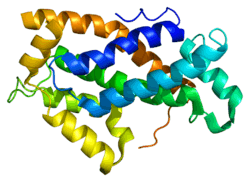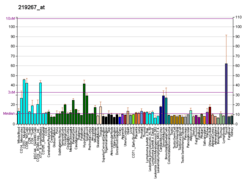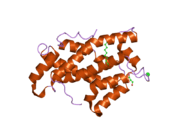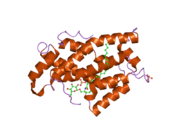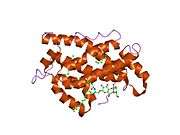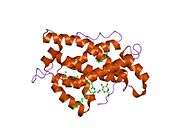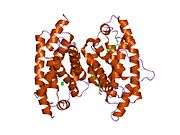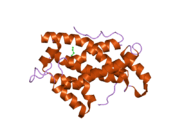GLTP
Glycolipid transfer protein is a protein that in humans is encoded by the GLTP gene.[5][6][7]
The protein encoded by this gene is similar to bovine and porcine proteins which accelerate transfer of certain glycosphingolipids and glyceroglycolipids between membranes. It is thought to be a cytoplasmic protein.[7]
References
- 1 2 3 GRCh38: Ensembl release 89: ENSG00000139433 - Ensembl, May 2017
- 1 2 3 GRCm38: Ensembl release 89: ENSMUSG00000011884 - Ensembl, May 2017
- ↑ "Human PubMed Reference:".
- ↑ "Mouse PubMed Reference:".
- ↑ Li XM, Malakhova ML, Lin X, Pike HM, Chung T, Molotkovsky JG, Brown RE (Aug 2004). "Human glycolipid transfer protein: probing conformation using fluorescence spectroscopy". Biochemistry. 43 (31): 10285–94. doi:10.1021/bi0495432. PMC 2593833. PMID 15287756.
- ↑ Malakhova ML, Malinina L, Pike HM, Kanack AT, Patel DJ, Brown RE (Jul 2005). "Point mutational analysis of the liganding site in human glycolipid transfer protein. Functionality of the complex". J Biol Chem. 280 (28): 26312–20. doi:10.1074/jbc.M500481200. PMC 1393170. PMID 15901739.
- 1 2 "Entrez Gene: GLTP glycolipid transfer protein".
Further reading
- Brown RE, Mattjus P (2007). "Glycolipid transfer proteins". Biochim. Biophys. Acta. 1771 (6): 746–60. doi:10.1016/j.bbalip.2007.01.011. PMC 1986823. PMID 17320476.
- Abe A (1990). "Primary structure of glycolipid transfer protein from pig brain". J. Biol. Chem. 265 (17): 9634–7. PMID 2190982.
- Bonaldo MF, Lennon G, Soares MB (1997). "Normalization and subtraction: two approaches to facilitate gene discovery". Genome Res. 6 (9): 791–806. doi:10.1101/gr.6.9.791. PMID 8889548.
- Mattjus P, Pike HM, Molotkovsky JG, Brown RE (2000). "Charged membrane surfaces impede the protein-mediated transfer of glycosphingolipids between phospholipid bilayers". Biochemistry. 39 (5): 1067–75. doi:10.1021/bi991810u. PMC 2637181. PMID 10653652.
- Lin X, Mattjus P, Pike HM, et al. (2000). "Cloning and expression of glycolipid transfer protein from bovine and porcine brain". J. Biol. Chem. 275 (7): 5104–10. doi:10.1074/jbc.275.7.5104. PMC 2621014. PMID 10671554.
- Strausberg RL, Feingold EA, Grouse LH, et al. (2003). "Generation and initial analysis of more than 15,000 full-length human and mouse cDNA sequences". Proc. Natl. Acad. Sci. U.S.A. 99 (26): 16899–903. doi:10.1073/pnas.242603899. PMC 139241. PMID 12477932.
- Malinina L, Malakhova ML, Teplov A, et al. (2004). "Structural basis for glycosphingolipid transfer specificity". Nature. 430 (7003): 1048–53. doi:10.1038/nature02856. PMC 2640488. PMID 15329726.
- Gerhard DS, Wagner L, Feingold EA, et al. (2004). "The status, quality, and expansion of the NIH full-length cDNA project: the Mammalian Gene Collection (MGC)". Genome Res. 14 (10B): 2121–7. doi:10.1101/gr.2596504. PMC 528928. PMID 15489334.
- Rao CS, Lin X, Pike HM, et al. (2004). "Glycolipid transfer protein mediated transfer of glycosphingolipids between membranes: a model for action based on kinetic and thermodynamic analyses". Biochemistry. 43 (43): 13805–15. doi:10.1021/bi0492197. PMC 2596630. PMID 15504043.
- Rao CS, Chung T, Pike HM, Brown RE (2006). "Glycolipid transfer protein interaction with bilayer vesicles: modulation by changing lipid composition". Biophys. J. 89 (6): 4017–28. doi:10.1529/biophysj.105.070631. PMC 1366967. PMID 16169991.
- Malinina L, Malakhova ML, Kanack AT, et al. (2006). "The liganding of glycolipid transfer protein is controlled by glycolipid acyl structure". PLoS Biol. 4 (11): e362. doi:10.1371/journal.pbio.0040362. PMC 1618416. PMID 17105344.
This article is issued from
Wikipedia.
The text is licensed under Creative Commons - Attribution - Sharealike.
Additional terms may apply for the media files.
